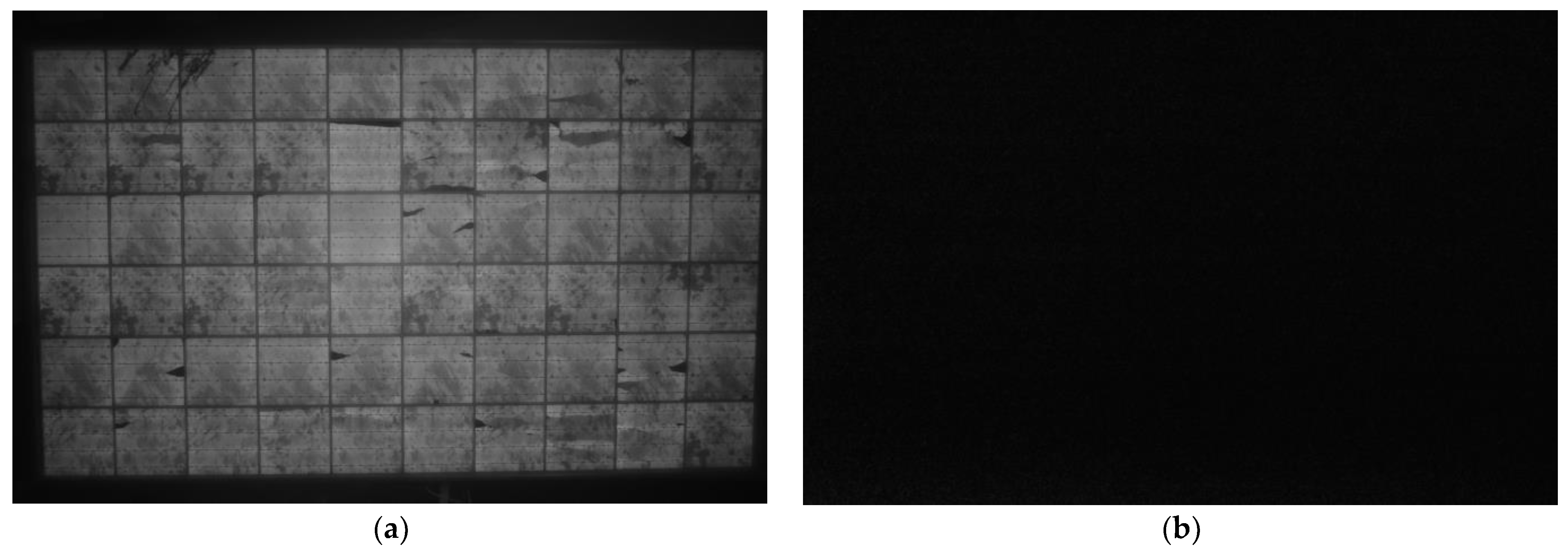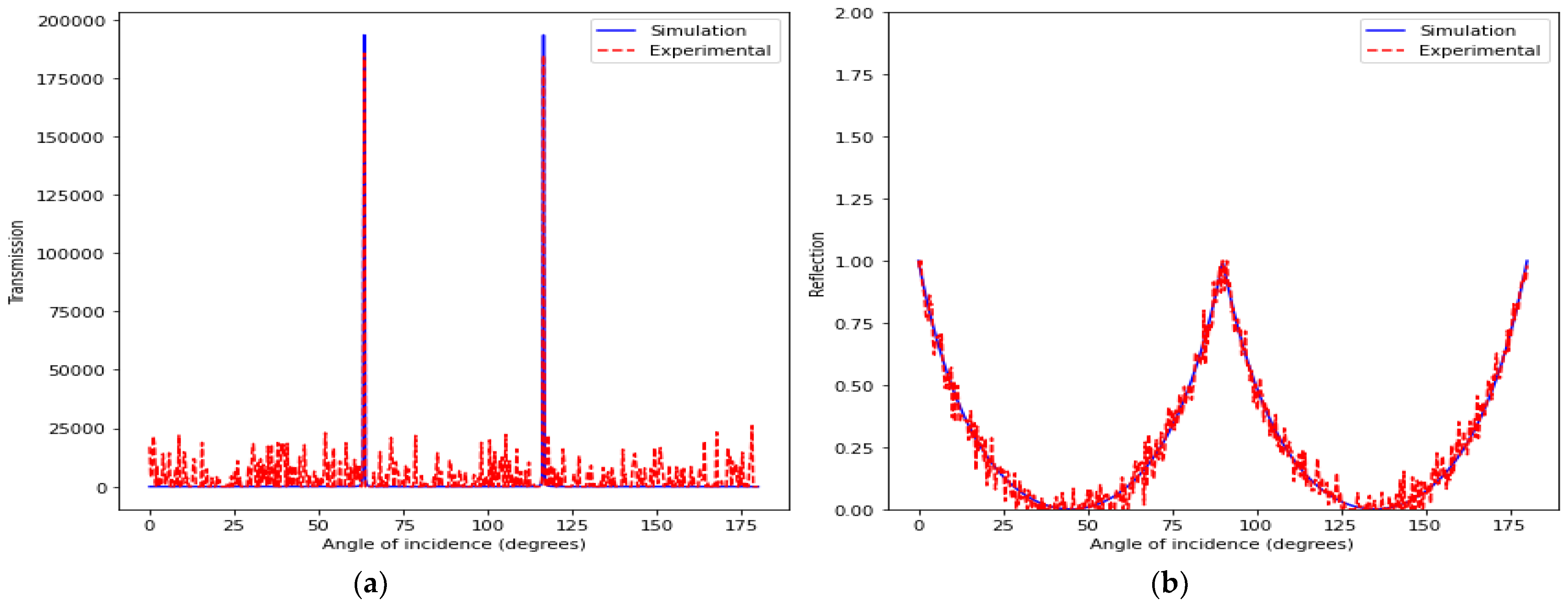Optical Filter Design for Daylight Outdoor Electroluminescence Imaging of PV Modules
Abstract
1. Introduction
2. Materials and Methods
2.1. EL Imaging and Inspection Procedure
- Preparation of the solar PV module: Before EL imaging can be conducted, the solar PV module must be prepared. This involves cleaning the module and removing any debris or shading materials that may interfere with the imaging process;
- Application of electrical bias: An electrical bias is applied to the solar PV module, which causes the cells to emit light in response to the applied voltage. The electrical bias is typically applied using a specialized EL camera and/or other test equipment;
- Imaging: The emitted light is captured by a camera, which produces an EL image of the solar PV module. The resulting image reveals any defects and/or issues in the cells, including cracks, dead cells, and other issues that may affect the performance of the module.
2.2. Optical Filter Design
- Dynamic range preservation: Lowering exposure time can limit the dynamic range of the camera sensor. The neutral density filter allows us to maintain a longer exposure, which is beneficial for capturing the full dynamic range of the EL signal, especially when documenting subtle defects or variations in the solar cells that could be lost with a shorter exposure;
- Signal-to-noise ratio: Gain adjustments affect the signal-to-noise ratio (SNR). Reducing gain to prevent saturation can also diminish the EL signal, potentially increasing the relative amount of noise in the image. The neutral density filter enables therefore to keep a lower gain setting, optimizing the SNR of the EL signal;
- Shutter speed and motion blur: Adjusting the shutter speed affects motion blur, which is a critical factor when imaging moving objects or when the camera is mounted on a moving platform such as a UAV. Hence, the neutral density filter allows for the use of optimal shutter speeds that minimize motion blur while still avoiding saturation;
- Depth of field: The creative manipulation of depth of field in photography often involves the use of neutral density filters in conjunction with longer exposure times. This combination allows photographers to exercise precise control over the focal plane in their images. For example, when photographing a solar panel, longer exposure times facilitated by neutral density filters can be strategically employed to ensure a specific plane of the panel is captured in sharp focus while intentionally softening the focus in other areas of the composition. This technique enables photographers to achieve visually striking results by adjusting the amount of light reaching the camera’s sensor over an extended duration;
- Consistent exposure technique: The variability of solar irradiance throughout the day can complicate the use of exposure time and gain adjustments as the sole methods for preventing saturation. A neutral density filter provides a consistent method to control light intensity. This is particularly advantageous when conducting serial inspections over time. Furthermore, the use of a neutral density filter allows for manual adjustment of its optical density to adapt to changing solar irradiance conditions during extended observations.
2.3. Image Processing and Signal-Noise Ratio (SNR) Metric
3. Results
3.1. Daylight Outdoor EL Test with and without Polization Filter
3.2. Daylight Outdoor EL Inspection with Different PV Modules and Configruations
4. Comparative Analysis
5. Conclusions
Author Contributions
Funding
Institutional Review Board Statement
Informed Consent Statement
Data Availability Statement
Conflicts of Interest
Appendix A
References
- Kouadri-Boudjelthia, E.; Chekired, F.; Belhaouas, N.; Smara, Z.; Mehareb, F. Bubbles formation on the photovoltaic cells fingers: Visual inspection of 30-year-old modules. Sol. Energy 2021, 230, 1013–1019. [Google Scholar] [CrossRef]
- Hassan, S.; Dhimish, M. Dual Spin Max Pooling Convolutional Neural Network for Solar Cell Crack Detection. Sci. Rep. 2023, 13, 11099. [Google Scholar] [CrossRef] [PubMed]
- Li, X.; Li, W.; Yang, Q.; Yan, W.; Zomaya, A.Y. An unmanned inspection system for multiple defects detection in photovoltaic plants. IEEE J. Photovolt. 2020, 10, 568–576. [Google Scholar] [CrossRef]
- Schuss, C.; Fabritius, T.; Eichberger, B.; Rahkonen, T. Impacts on the output power of photovoltaics on top of electric and Hybrid Electric Vehicles. IEEE Trans. Instrum. Meas. 2020, 69, 2449–2458. [Google Scholar] [CrossRef]
- Cheng, C.; Liu, M.; Yi, H.; Ran, G.; Chen, H. Slow manifold analysis-based detection of hot spots in photovoltaic systems. IEEE Trans. Instrum. Meas. 2022, 71, 3516510. [Google Scholar] [CrossRef]
- Schuss, C.; Remes, K.; Leppanen, K.; Saarela, J.; Fabritius, T.; Eichberger, B.; Rahkonen, T. Detecting defects in photovoltaic panels with the help of synchronized thermography. IEEE Trans. Instrum. Meas. 2018, 67, 1178–1186. [Google Scholar] [CrossRef]
- Di Tommaso, A.; Betti, A.; Fontanelli, G.; Michelozzi, B. A multi-stage model based on yolov3 for defect detection in PV panels based on IR and visible imaging by Unmanned Aerial Vehicle. Renew. Energy 2022, 193, 941–962. [Google Scholar] [CrossRef]
- Vergura, S. Criticalities of the outdoor infrared inspection of photovoltaic modules by means of drones. Energies 2022, 15, 5086. [Google Scholar] [CrossRef]
- Nooralishahi, P.; Ibarra-Castanedo, C.; Deane, S.; López, F.; Pant, S.; Genest, M.; Avdelidis, N.P.; Maldague, X.P. Drone-based non-destructive inspection of industrial sites: A review and case studies. Drones 2021, 5, 106. [Google Scholar] [CrossRef]
- Masita, K.; Hasan, A.; Shongwe, T. 75MW AC PV module field anomaly detection using drone-based IR orthogonal images with RES-CNN3 detector. IEEE Access 2022, 10, 83711–83722. [Google Scholar] [CrossRef]
- Høiaas, I.; Grujic, K.; Imenes, A.G.; Burud, I.; Olsen, E.; Belbachir, N. Inspection and condition monitoring of large-scale photovoltaic power plants: A Review of Imaging Technologies. Renew. Sustain. Energy Rev. 2022, 161, 112353. [Google Scholar] [CrossRef]
- Morando, L.; Recchiuto, C.T.; Calla, J.; Scuteri, P.; Sgorbissa, A. Thermal and visual tracking of photovoltaic plants for autonomous UAV inspection. Drones 2022, 6, 347. [Google Scholar] [CrossRef]
- Dhimish, M.; Badran, G. Recovery of photovoltaic potential-induced degradation utilizing automatic indirect voltage source. IEEE Trans. Instrum. Meas. 2022, 71, 2000209. [Google Scholar] [CrossRef]
- Pratt, L.; Govender, D.; Klein, R. Defect detection and quantification in electroluminescence images of solar PV modules using U-net Semantic segmentation. Renew. Energy 2021, 178, 1211–1222. [Google Scholar] [CrossRef]
- Dhimish, M.; Badran, G. Investigating defects and annual degradation in UK solar PV installations through thermographic and electroluminescent surveys. NPJ Mater. Degrad. 2023, 7, 14. [Google Scholar] [CrossRef]
- Dhimish, M.; Holmes, V. Solar cells micro crack detection technique using state-of-the-art electroluminescence imaging. J. Sci. Adv. Mater. Devices 2019, 4, 499–508. [Google Scholar] [CrossRef]
- Pratt, L.; Mattheus, J.; Klein, R. A benchmark dataset for defect detection and classification in electroluminescence images of PV modules using semantic segmentation. Syst. Soft Comput. 2023, 5, 200048. [Google Scholar] [CrossRef]
- Lv, X.; Ako, R.T.; Bhaskaran, M.; Sriram, S.; Fumeaux, C.; Withayachumnankul, W. Frequency-selective-surface-based mechanically reconfigurable terahertz bandpass filter. IEEE Trans. Terahertz Sci. Technol. 2022, 12, 257–266. [Google Scholar] [CrossRef]
- Nelfyenny; Achmadi, A.; Prihhapso, Y.; Farhania, W.; Suryani, D.; Zaini, H. The effect of glass neutral density filter on illuminance measurement error. J. Phys. Conf. Ser. 2021, 1918, 022028. [Google Scholar] [CrossRef]
- Degert, J.; Tondusson, M.; Freysz, V.; Abraham, E.; Kumar, S.; Freysz, E. Ultrafast, broadband and tunable terahertz reflector and Neutral Density filter based on high resistivity silicon. Opt. Express 2022, 30, 18995. [Google Scholar] [CrossRef]
- dos Reis Benatto, G.A.; Santamaria, R.D.P.; Hass, T.K.; Bartholomäus, M.; Morino, L.; Poulsen, P.B.; Spataru, S.V. Daylight Electroluminescence of PV Modules in Field Installations: When Electrical Signal Modulation is Required? In Proceedings of the 8th World Conference on Photovoltaic Energy Conversion, Milan, Italy, 26–30 September 2022; pp. 735–739. [Google Scholar]
- dos Reis Benatto, G.A.; Mayordomo, A.A.; Hass, T.K.; Santamaria, R.D.P.; Poulsen, P.B.; Spataru, S.V. Characterizing the Performance of Daylight Filters for Electroluminescence Imaging of Crystalline Silicon PV Modules. In Proceedings of the 40th European Photovoltaic Solar Energy Conference and Exhibition, Lisbon, Portugal, 18–22 September 2023; p. 020372. [Google Scholar]
- Santamaria, R.D.P.; dos Reis Benatto, G.A.; Hass, T.K.; Morino, L.; Poulsen, P.B.; Spataru, S.V. Challenges of Aerial Drone Electroluminescence in Solar Photovoltaic Field Inspections. In Proceedings of the 40th European Photovoltaic Solar Energy Conference and Exhibition, Lisbon, Portugal, 18–22 September 2023; p. 020403. [Google Scholar]
- Vuković, M.; Høiaas, I.E.; Jakovljević, M.; Flø, A.S.; Olsen, E.; Burud, I. Outdoor photoluminescence and electroluminescence imaging of photovoltaic silicon modules in a string. AIP Conf. Proc. 2022, 2487, 030012. [Google Scholar]
- Terrados, C.; González-Francés, D.; Alonso, V.; González, M.A.; Jiménez, J.; Martínez, O. Comparison of Outdoor and Indoor PL and EL Images in Si Solar Cells and Panels for Defect Detection and Classification. J. Electron. Mater. 2023, 52, 5189–5198. [Google Scholar] [CrossRef]
- dos Reis Benatto, G.A.; Hass, T.K.; Santamaria, R.D.P.; Spataru, S.V.; Terrados, C.; González-Francés, D.; Anaya, J.; Sulca, K.; Gómez-Alonso, V.; González, M.Á.; et al. Daylight Electroluminescence Imaging Methodology Comparison. In Proceedings of the 40th European Photovoltaic Solar Energy Conference and Exhibition, Lisbon, Portugal, 18–22 September 2023; p. 020374. [Google Scholar]










Disclaimer/Publisher’s Note: The statements, opinions and data contained in all publications are solely those of the individual author(s) and contributor(s) and not of MDPI and/or the editor(s). MDPI and/or the editor(s) disclaim responsibility for any injury to people or property resulting from any ideas, methods, instructions or products referred to in the content. |
© 2024 by the authors. Licensee MDPI, Basel, Switzerland. This article is an open access article distributed under the terms and conditions of the Creative Commons Attribution (CC BY) license (https://creativecommons.org/licenses/by/4.0/).
Share and Cite
Dhimish, M.; Tyrrell, A.M. Optical Filter Design for Daylight Outdoor Electroluminescence Imaging of PV Modules. Photonics 2024, 11, 63. https://doi.org/10.3390/photonics11010063
Dhimish M, Tyrrell AM. Optical Filter Design for Daylight Outdoor Electroluminescence Imaging of PV Modules. Photonics. 2024; 11(1):63. https://doi.org/10.3390/photonics11010063
Chicago/Turabian StyleDhimish, Mahmoud, and Andy M. Tyrrell. 2024. "Optical Filter Design for Daylight Outdoor Electroluminescence Imaging of PV Modules" Photonics 11, no. 1: 63. https://doi.org/10.3390/photonics11010063
APA StyleDhimish, M., & Tyrrell, A. M. (2024). Optical Filter Design for Daylight Outdoor Electroluminescence Imaging of PV Modules. Photonics, 11(1), 63. https://doi.org/10.3390/photonics11010063





